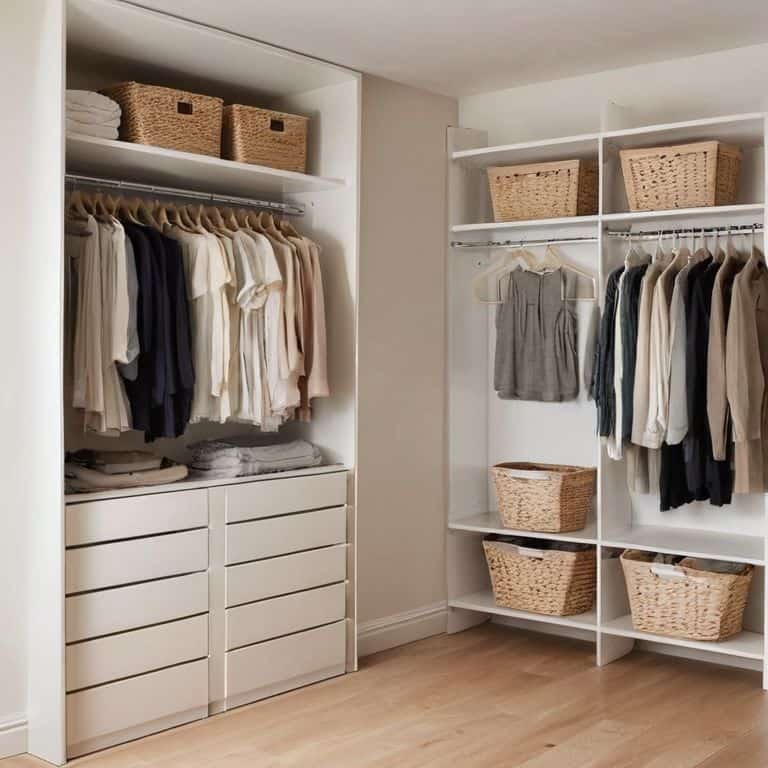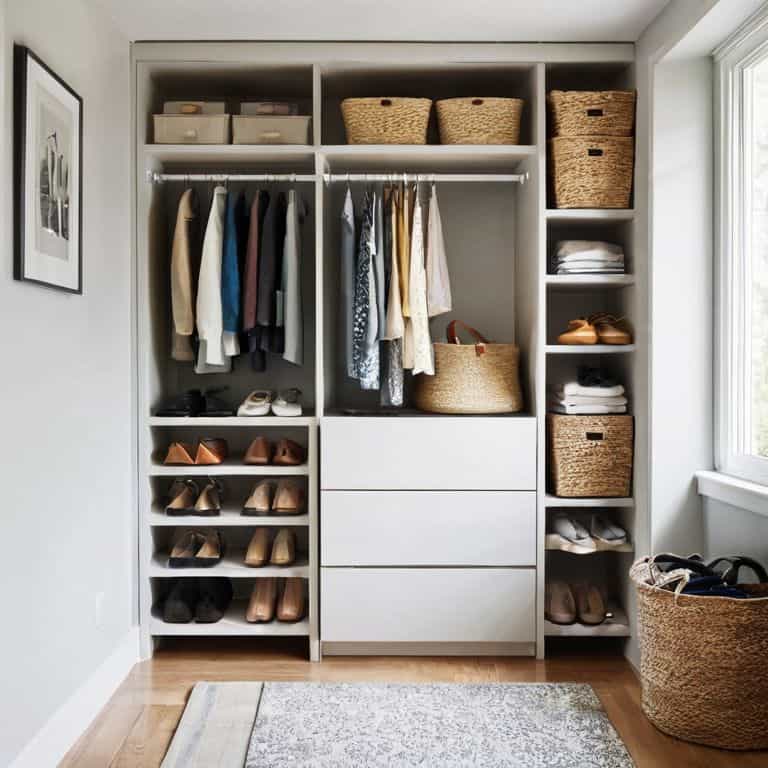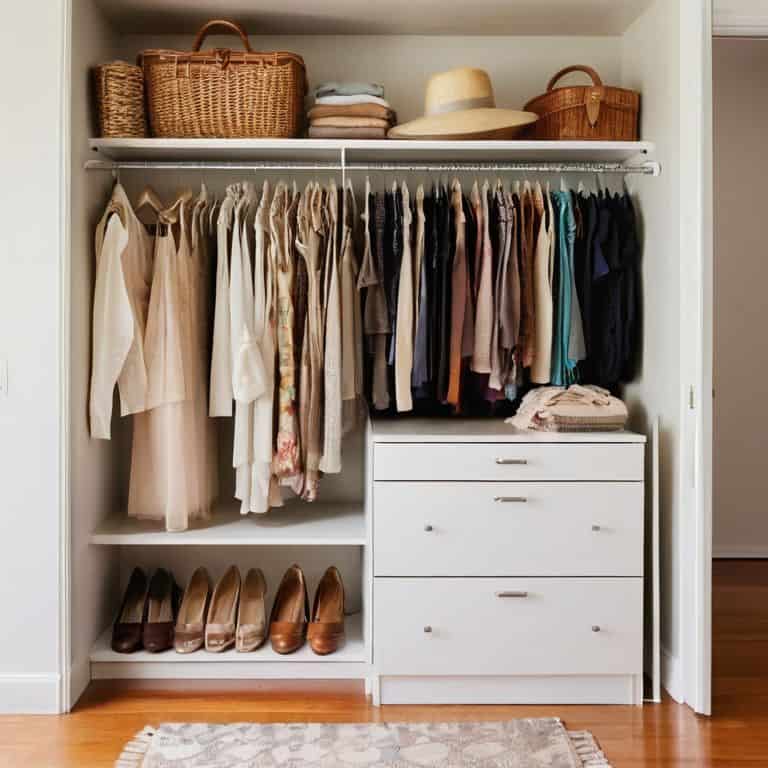I still remember the day I realized that organizing a small closet wasn’t about magically expanding the space, but about creating a system that worked with what I had. I was in my tiny apartment, digging through a pile of clothes that seemed to have no end, and I thought to myself: “There has to be a better way to how to organize a small closet.” The common myth that you need a lot of space to be organized is just that – a myth. What you need is a clear plan, a willingness to let go of what’s not serving you, and a few clever tricks up your sleeve.
In this article, I’ll share my step-by-step approach to taming even the most chaotic of small closets. You’ll learn how to sort and purge your belongings, create a functional layout, and implement habits that will keep your space organized for the long haul. My goal is to give you the practical tools you need to take control of your closet, without any fluffy advice or unrealistic expectations. By the end of this guide, you’ll be equipped with the knowledge and confidence to turn your small closet into a peaceful, functional oasis that makes your daily routine easier and more enjoyable.
Table of Contents
Guide Overview: What You'll Need

Total Time: 2 hours 30 minutes
Estimated Cost: $50 – $100
Difficulty Level: Intermediate
Tools Required
- Tape Measure (for measuring closet space)
- Level (for ensuring shelves are straight)
- Drill (with screwdriver and drill bits)
- Hammer (for tapping shelves into place)
- Utility Knife (with extra blades)
Supplies & Materials
- Shelving Units (adjustable to fit closet space)
- Stackable Containers (for storing folded clothes or accessories)
- Double Rod (for doubling hanging space)
- Shelf Dividers (for organizing shelves)
- Hooks (for hanging belts, bags, or accessories)
- 2-in x 4-in lumber (for creating custom shelves)
- Wood Screws (for assembling shelving units)
- Wall Anchors (for securing shelves to wall)
Step-by-Step Instructions
- 1. First, let’s take everything out of your closet. Yes, you read that right – everything. This is the part where most people want to run and hide, but trust me, it’s essential to start with a blank slate. Take out all the clothes, shoes, accessories, and storage containers. You’ll be surprised at how much easier it is to organize when you can see everything you’re working with.
- 2. Next, sort items into three piles: keep, donate/sell, and discard. Be ruthless – if you haven’t worn something in a year, it’s probably safe to get rid of it. Consider the 80/20 rule: 80% of the time, you likely wear 20% of your clothes. Keep this in mind when deciding what to keep and what to let go of.
- 3. Now that you have your keep pile, let’s categorize and group similar items together. For example, all your tops will go in one section, all your bottoms in another, and so on. This will make it easier to find what you need when you need it. Use storage containers or bins to keep items like socks and underwear organized and out of the way.
- 4. It’s time to think about vertical space. Since your closet is small, you’ll want to maximize the use of your walls. Consider installing shelves, hooks, or a pegboard to hang items like jackets, bags, or accessories. This will help keep your floor and surfaces clear, making your closet feel more spacious.
- 5. Once you have your storage solutions in place, it’s time to assign a home for each item. This means designating a specific spot for each thing, so it’s easy to find and put back. Use labels or signs to help you remember where everything goes. This might seem like a small thing, but it’s a game-changer for maintaining your newly organized closet.
- 6. Let’s not forget about shoe storage. If you have a lot of shoes, consider investing in a shoe rack or over-the-door shoe organizer. This will keep your shoes organized, easy to find, and off the floor. You can also use stackable shoe boxes or containers to store out-of-season shoes or less frequently worn pairs.
- 7. Finally, maintain your space by setting aside some time each week to keep your closet organized. Go through your clothes and accessories, and get rid of anything that’s no longer needed or useful. Use this time to also review and adjust your organizational system as needed. Life changes, and your closet organization should too – don’t be afraid to make adjustments to keep your system working for you.
Taming Tiny Spaces

When it comes to small closet shelving ideas, it’s all about maximizing vertical space. Consider installing shelves or storage units that go up to the ceiling to make the most of your tiny closet. This will not only provide more storage but also keep your floor clear, making the space feel larger. I like to use folded clothing storage solutions to keep my clothes organized and easy to find.
To take your closet organization to the next level, think about custom closet systems on a budget. You don’t have to break the bank to create a functional and stylish closet. Look for affordable options like DIY shelving or repurposed furniture to create a unique and functional space. Don’t forget to utilize closet corners by using corner shelves or carousels to store items like shoes or accessories.
By implementing these tips, you can create a closet that is both functional and beautiful. Remember to keep your closet door organized with closet door organization hacks like over-the-door storage or hooks. This will help keep your closet clutter-free and make the most of your tiny space. With a little creativity and planning, you can turn your small closet into a peaceful and organized oasis.
Maximizing Corner Space With Custom Systems
To truly maximize the potential of your small closet, let’s talk about corner space. Often, this area gets neglected, but with the right approach, it can become a highly functional part of your storage system. I recommend creating a custom carousel or Lazy Susan for your corner. This simple addition can double your storage capacity in that area, making it easy to access items that would otherwise be hidden or hard to reach.
By installing a custom system, you can ensure that every inch of your closet is working for you, not against you. For a budget-friendly option, consider repurposing an old carousel or purchasing an affordable one from a home goods store. With a little creativity, your closet’s corner space can go from wasted to wonderful, providing a neat and organized spot for shoes, bags, or accessories.
Small Closet Shelving Ideas on a Budget
When it comes to small closet shelving, you don’t have to break the bank. I’m a big fan of repurposing items like old crates, boxes, or even luggage to create unique storage solutions. You can also find affordable shelves at thrift stores or garage sales. To get started, make a list of the items you need to store, and then measure your closet space to determine the best shelving configuration. Consider using stackable shelves or hanging rods with built-in shelves to maximize your vertical space.
For a budget-friendly option, try using DIY shelves made from plywood or MDF boards. You can find plenty of tutorials online to guide you through the process. Alternatively, look for affordable shelving units at IKEA or other budget-friendly furniture stores. Remember, the key to small closet shelving is to keep it simple and functional. By getting creative with your shelving solutions, you can create a organized and peaceful space without overspending.
5 Essential Tips to Supercharge Your Small Closet Organization
- Start with a purge: Take everything out of your closet and sort items into three piles – keep, donate/sell, and discard – to get a clear picture of what you have and what you need to organize
- Use vertical space: Install shelves, hooks, or a pegboard to maximize your closet’s vertical space and keep items off the floor and out of the way
- Choose multi-functional storage: Invest in storage containers, bins, or baskets that can serve multiple purposes, such as storing clothes, accessories, or shoes, to make the most of your closet’s limited space
- Implement a ‘home’ system: Assign a designated spot for each item in your closet, making it easier to find what you need and maintain your newly organized space
- Maintain your space: Schedule regular tidying sessions to keep your closet organized and clutter-free, and make adjustments to your system as needed to ensure it continues to work for you
Key Takeaways for a Clutter-Free Closet
By applying a step-by-step approach to closet organization, you can transform a small, chaotic space into a functional area that boosts your daily productivity
Implementing budget-friendly shelving ideas and custom corner systems can help maximize storage capacity without breaking the bank
Remember, the key to maintaining a clutter-free closet is to create a system that works for you and stick to it, using tools like flowcharts to map out your organization strategy and make adjustments as needed
Taming the Chaos
The key to organizing a small closet isn’t about finding more space, it’s about creating a system that makes the most of what you have – and that starts with taking control of the chaos, one step at a time.
Sloane Kendrick
From Chaos to Control: Celebrating Your Small Closet Victory

As we wrap up this journey to tame the chaos of your small closet, let’s recap the key strategies we’ve covered: from implementing a step-by-step organization plan, to exploring budget-friendly shelving ideas, and maximizing corner space with custom systems. These practical tips are designed to help you overcome the unique challenges of small closet spaces and create a system that truly works for you. By applying these methods, you’ll not only find your favorite shoes in under 30 seconds, but you’ll also experience a sense of clarity and control that spills over into other areas of your life.
So, as you stand in your now-organized closet, feeling a sense of pride and accomplishment, remember that creating order is a process. It’s okay to take it one step at a time, and to make adjustments as you go. The goal is not to create a perfect, magazine-worthy space, but to craft a functional, peaceful area that supports your daily life. Congratulations on taking the first steps towards a more organized, more serene you – and don’t forget to enjoy the journey, one flowchart at a time!
Frequently Asked Questions
How can I decide what clothes to keep and what to discard in my small closet?
Let’s simplify this decision with a flowchart-worthy question: When was the last time you wore it? Be honest! If it’s been over a year, it’s likely safe to let it go. I also recommend asking yourself: Does it fit? Is it in good condition? Does it make me feel great? If you’re still unsure, try the hanger trick: hang clothes with hangers facing the opposite direction, and when you wear something, hang it back up normally. After a few months, consider discarding items that are still facing the opposite direction.
What are some space-saving options for storing shoes in a tiny closet?
For shoe storage in a tiny closet, I swear by over-the-door shoe organizers or stackable shoe racks. You can also use hanging shoe cubbies or under-shelf shoe storage to maximize vertical space. I’ve even used flowcharts to optimize shoe storage for my clients – it’s all about finding the right system for your space and style!
Can I use DIY shelving and storage solutions to organize my small closet on a tight budget?
Absolutely, DIY shelving and storage can be a game-changer for small closet organization on a budget. I recommend repurposing items like wooden crates, baskets, or even hooks to create a functional and affordable storage system. Get creative and have fun with it – your wallet (and your closet) will thank you!
